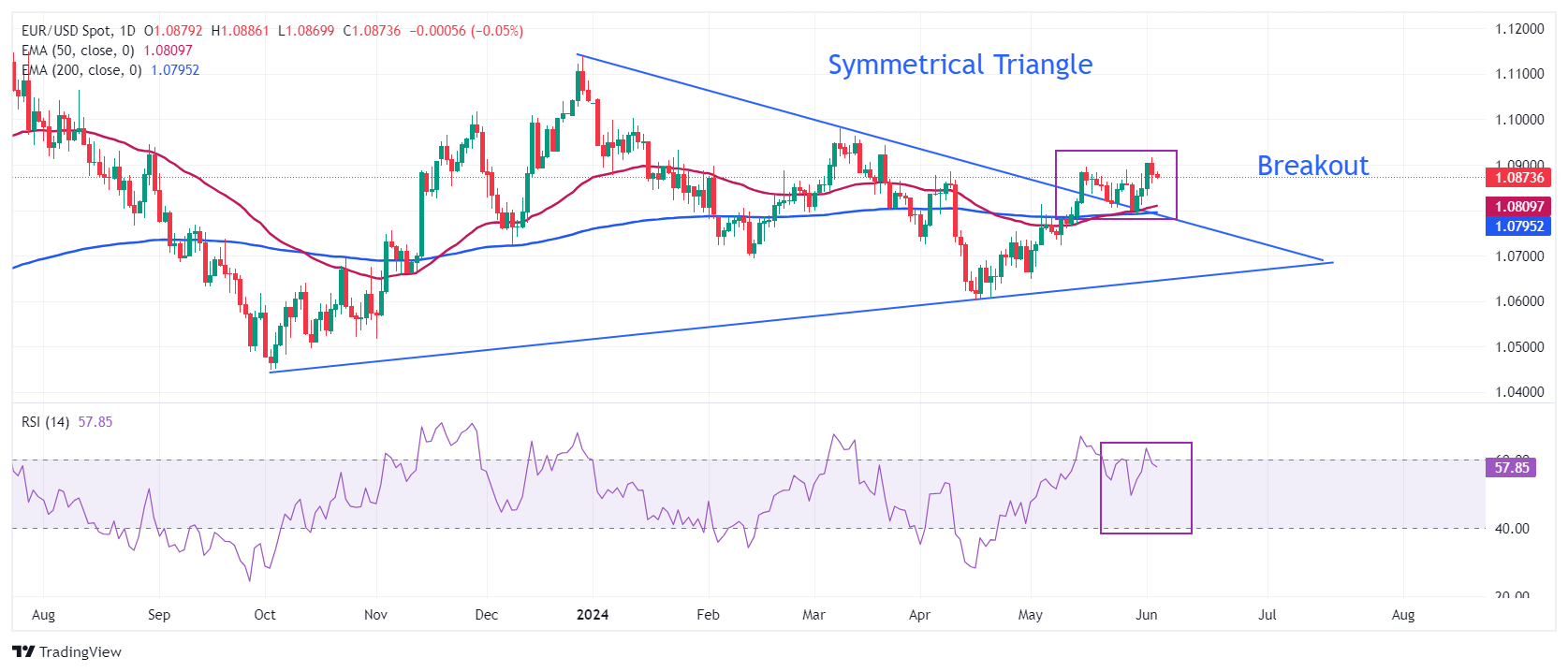EUR/USD ticks down ahead of ECB policy meeting and crucial US economic data

- EUR/USD falls slightly with the focus on the ECB policy meeting and US economic data.
- The ECB is widely expected to deliver a rate-cut move with a data-dependent approach for the interest rate path.
- Normalizing US labor market conditions has boosted Fed rate-cut bets for September.
EUR/USD drops from 1.0880 in Wednesday’s European session. The major currency pair falls amid caution ahead of the European Central Bank’s (ECB) interest rate decision, which will be announced on Thursday.
The ECB is widely anticipated to cut its Deposit Facility rate by 25 basis points (bps) to 3.75%. Therefore, investors will focus on the ECB’s guidance on the interest rate outlook to project the next move in the Euro.
Higher-than-expected increase in the Eurozone’s annual Harmonized Index of Consumer Prices (HICP) data, service inflation and Q1 Gross Domestic Product (GDP) suggest that price pressures could become persistent in the coming months. Therefore, ECB officials would prefer to remain data-dependent and push back expectations for subsequent rate cuts. Currently, financial markets expect that the ECB will cut interest rates at least twice this year.
Daily digest market movers: EUR/USD falls ahead of US ISM Services PMI
- EUR/USD edges down around 1.0880 as the US Dollar index (DXY) rebounds ahead of the crucial United States (US) economic calendar on Wednesday: The ADP Employment Change and the Institute for Supply Management’s (ISM) Services Purchasing Managers Index (PMI) data for May, which will be published at 12:15 and 14:00 GMT, respectively.
- Economists have forecasted that US private employers hired 173K job-seekers in May, lower than the former reading of 192K. A slower hiring pace would deepen fears of normalizing labor market conditions. On Tuesday, the US JOLTS Job Opening report showed that job postings came in lower at 8.06 million in April, from the expectations of 8.34 million and the former release of 8.35 million.
- The perception of normalizing labor market conditions and the economy’s growth prospects have fuelled expectations that the Federal Reserve (Fed) will begin lowering interest rates from the September meeting. The CME FedWatch tool shows that the probability of a rate cut in the September meeting has increased to 65% from 47% a week ago.
- Meanwhile, the US ISM Services PMI is estimated to have returned to expansion, seen at 50.5, higher than the former reading of 49.4. Investors will keenly focus on the Services PMI as it gauges the service sector activity, which accounts for two-thirds of the economy. In addition to services PMI, investors will also focus on other subcomponents, such as New Orders and Prices Paid indices, which reflect forward demand and changes in input prices.
- Later this week, the release of the US Nonfarm Payrolls (NFP) report for May will significantly influence market speculation about the Fed reducing interest rates from the September meeting.
Technical Analysis: EUR/USD consolidates below 1.0900
EUR/USD hovers around 1.0880 ahead of crucial US economic data. The major currency pair trades inside Tuesday’s trading range. The near-term outlook of the pair remains firm due to the Symmetrical Triangle breakout on a daily timeframe and upward-sloping 50-day Exponential Moving Average (EMA), which trades around 1.0800.
The 14-period Relative Strength Index (RSI) has slipped into the 40.00-60.00 range, suggesting that the momentum, which was leaned toward the upside, has faded for now.
The major currency pair is expected to extend its upside towards the March 21 high, around 1.0950, and the psychological resistance of 1.1000 if it breaks above the round-level resistance of 1.0900 decisively. However, a downside move below the 200-day EMA at 1.0800 could push it into the bearish trajectory.
Economic Indicator
ECB Press Conference
Following the European Central Bank’s (ECB) economic policy decision, the ECB President gives a press conference regarding monetary policy. The president’s comments may influence the volatility of the Euro (EUR) and determine a short-term positive or negative trend. If the president adopts a hawkish tone it is considered bullish for the EUR, whereas if the tone is dovish the result is usually bearish for the Euro.
Next release: Thu Jun 06, 2024 12:45
Frequency: Irregular
Consensus: –
Previous: –
Source: European Central Bank
